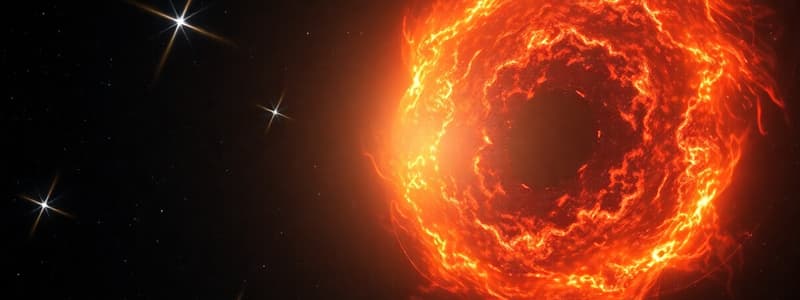Podcast
Questions and Answers
What is the primary component of the solar system's mass?
What is the primary component of the solar system's mass?
- Asteroids
- The Sun (correct)
- Comets
- Planets
Which of the following planets has the largest number of moons?
Which of the following planets has the largest number of moons?
- Earth
- Mars
- Saturn
- Jupiter (correct)
Which layer of the Sun is responsible for its energy output?
Which layer of the Sun is responsible for its energy output?
- Core (correct)
- Convective Zone
- Photosphere
- Radiative Zone
What distinguishes terrestrial planets from gas giants?
What distinguishes terrestrial planets from gas giants?
What is the defining feature of a dwarf planet?
What is the defining feature of a dwarf planet?
Flashcards
Kepler's Third Law
Kepler's Third Law
The square of the orbital period of a planet is directly proportional to the cube of the semi-major axis of its orbit.
Orbital Period
Orbital Period
Time it takes a planet to complete one full orbit around a star.
Semi-major axis
Semi-major axis
Half of the longest diameter of an ellipse.
Ellipse
Ellipse
Signup and view all the flashcards
Newton's Law of Universal Gravitation
Newton's Law of Universal Gravitation
Signup and view all the flashcards
Study Notes
-
Stellar Evolution: Overview
- Stars form from giant molecular clouds, collapsing under gravity.
- Stars spend most of their lives in a stable state called the main sequence, where nuclear fusion converts hydrogen to helium.
- The lifetime of a star depends on its mass: more massive stars live shorter lives.
- After a star exhausts its hydrogen fuel, its evolution depends significantly on its mass.
-
Main Sequence Stars (Nuclear Fusion)
- Hydrogen fusion occurs in the core, converting hydrogen to helium.
- This fusion releases enormous amounts of energy that resist the inward pull of gravity.
- The inward pressure and the outward pressure due to fusion maintain the star in balance.
-
Stellar Clusters and Star Formation
- Stars are often found in clusters that formed at roughly the same time.
- By studying the cluster's main sequence stars, astronomers can estimate the cluster's age.
-
Low-Mass Stars: Red Giants and Planetary Nebulae
- When hydrogen in the core is depleted, the star expands and becomes a red giant.
- Helium fusion then occurs in the core.
- Red giants eventually fuse helium to carbon.
- Low-mass stars expel their outer layers during the final stages which form a planetary nebula.
- The remaining core becomes a white dwarf, which is very dense and gradually cools.
-
High-Mass Stars: Supernovae and Neutron Stars/Black Holes
- High-mass stars fuse heavier elements like carbon, oxygen, silicon, up to iron in their cores.
- Fusion of elements heavier than iron is not exothermic; the star's core collapses under its own immense gravity.
- This rapid collapse causes a massive explosion known as a supernova.
- After the explosion, the core may become a neutron star, which is extremely dense.
- If the remaining core has a mass greater than a certain limit (about 3 times the mass of the Sun), it becomes a black hole.
- When material falls into a black hole, nothing can escape its powerful gravity, not even light.
-
Hertzsprung-Russell (HR) Diagram
- Plots the luminosity and temperature of stars.
- Different stages of stellar evolution appear as tracks on the HR diagram.
- The main sequence is a diagonal band on the HR diagram where most stars reside during their stable phase.
- Red giants appear at the upper right of the HR diagram.
- White dwarfs appear at the lower left.
-
Comparing Star Types by Mass
- Lower mass stars have longer lifetimes because they consume their fuel more slowly.
- Higher mass stars fuse material more rapidly and produce more intense forms of radiation.
-
Stellar Nucleosynthesis
- The process of creating new atomic nuclei by combining existing nuclei.
- This process is responsible for the formation of most elements heavier than hydrogen and helium.
- It occurs primarily in the cores of stars during different stages of their evolution.
-
Supernova Remnants
- These remnants are the leftover material from a supernova explosion.
- They contain heavier elements produced in the star and scattered into space.
- These remnants can provide crucial information about the explosion process and composition of the progenitor star.
-
The Evolution of Stars in Binary Systems
- Two stars orbiting each other can have a significant impact on their evolution.
- Mass transfer between the stars can alter their evolution.
Studying That Suits You
Use AI to generate personalized quizzes and flashcards to suit your learning preferences.




